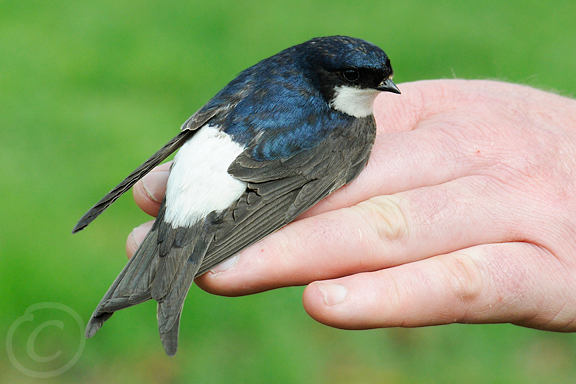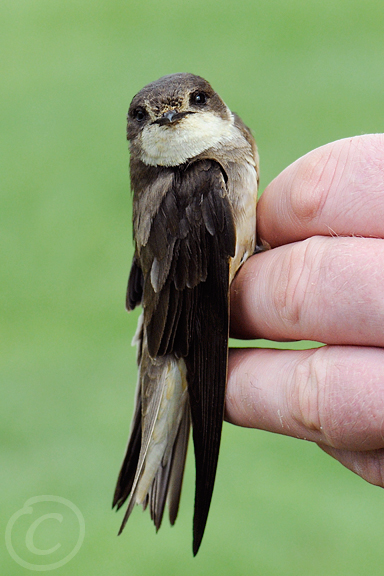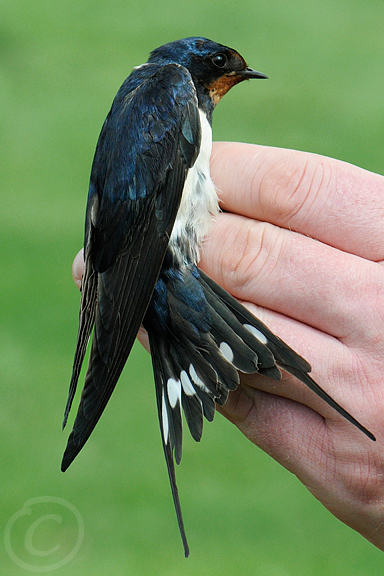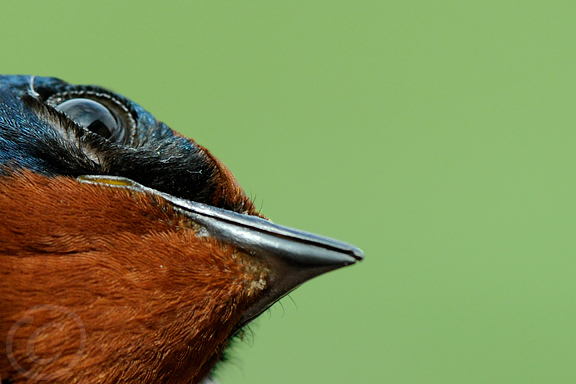Bird Ringing – how safe are mist nets?
How safe are mist nets?
Photo: Sand Martins in mist net by © Rebecca Nason
The following article has been forwarded to me and I thought I’d share in with my fellow birding bloggers, many of whom may be bird ringers/banders or have a general interest in the use of mist nets in bird research and conservation. Ringers in the UK have to go through strict supervised training by BTO ringing trainers before they are allowed to use mist nets and obtain a mist net endorsement license.
If you would like to know more about ringing in the UK, the standards for which are world renowned, or might like to become a trainee, please see the ringing section on the British Trust for Ornithology website ringing pages: www.bto.org.uk
Frequently Captured Birds Found to be at Less Risk of Injury Compared to
Birds Captured Once.Capturing birds using mist nets to study behaviour, movement or the
demographics of a species is one of the most common research techniques in
ornithology, yet until now there have been no large scale studies into the
risks mist nets pose to birds. Writing in the British Ecological Societys
Methods in Ecology and Evolution researchers from California used a
dataset of over 345,000 records to evaluate the risks of mist netting.The research, led by Erica Spotswood from the University of California at
Berkeley, used data from organisations across the United States and Canada
to assess the risk factors which could increase rates of injury or
mortality including bird size, age, frequency of capture and the role of
predators.The results revealed that birds are rarely injured or killed by mist nets.
Of 620,997 captures the percentage of incidents of injury amounting to
0.59% while only 0.23% of captures resulted in mortality. The authors then
began to analyse risk factors which could lead to increased incidents.Spotswood first discovered the lack of research into mist netting while
applying to study the Gray-green Fruit Dove in French Polynesia. When
concerned officials denied her permit and questioned the safety of
capturing birds with mist nets Spotswood realised that no comprehensive
study quantifying the frequency of bird injuries during mist netting
existed.I was very surprised to find that no study of this kind existed, because
mist netting has been around since the 1950s and is an extremely widely
used and common technique for monitoring bird populations,” said
Spotswood. “In the United States at least one million new birds are banded
each year at several hundred bird observatories around the country.”The authors compiled a dataset of documented bird injuries and mortalities
from 22 bird banding organisations across the United States and Canada,
resulting in a dataset of over 345,000 records of capture, spanning more
than 20 years of research and featuring 188 species of birds.Using this enormous dataset we could consider not only the rate of
injuries, but could ask which species are most at risk and what kinds of
incident are most common, said Spotswood. What began as an inquiry for a
permit application ended up evolving into something we feel will be of
value to the scientific community.The team also analysed how repeated capture can affect the likelihood of
incident and were surprised to discover that birds which were captured
more frequently were less at risk than birds which were only captured
once. The team suggest this is because frequently captured birds are more
likely to be established adults with territories, which are commonly in
better condition than birds that dont have territories.Finally the team found that birds which were released with an injury were
just as likely to be recaptured as birds without, meaning that injured
birds continue to survive in similar numbers to uninjured birds, meaning
the long term impact of mist netting is minimal.A lot of wildlife research requires that animals are captured and handled
in order to study populations, demographics, behaviour or movement, yet
the process can be stressful to animals. For both ethical reasons and the
sake of the research, it is important to make absolutely sure any risks
are minimized, concluded Spotswood.Our study fills in an important gap in understanding by evaluating one of
the most commonly used methods in ornithological research. We have shown
that when banders follow good practices, incidents are rare. We hope that
the results of this paper will be widely read by the banding community and
that it will help researchers minimize any risk of incident.
——————————————————————————–
The full article can be downloaded as a pdf.
This study is published in the British Ecological Society’s Methods in
Ecology and Evolution.
Full citation:
Spotswood, E. N., Goodman, K. R., Carlisle, J., Cormier, R. L., Humple, D. L., Rousseau, J., Guers, S. L. and Barton, G. G. (2011), How safe is mist netting? evaluating the risk of injury and mortality to birds. Methods in Ecology and Evolution, 2: no. doi: 10.1111/j.2041-210X.2011.00123.x
Netting Swallows
This last week has seen Phil and I flick netting Barn Swallow, Sand Martin and House Martin at our local Suffolk sewage works where we have permission to be on site to ring. With the extremely variable weather of the last few days, which has included 30 degree heat one minute and the biggest thunderstorms I’ve ever witnessed in the UK the next, it has been interesting to watch the hirundines and see which weather conditions favour catching.
The low pressure does seem to bring the birds down low to feed and even more so after a heavy shower. . . which has seen us pretty soaked at times! We have caught over 60 hirundines at the sewage works this past week and 2 of these were UK controls – as in, they already have rings on and were ringed elsewhere – we can’t wait to see where they are from! Here are a few pics of our sewage work successes of this week . . .
An adult House Martin showing the big white rump . . ..
An adult Sand Martin – many of the adults we caught had dirty sand colouring to their bellies where they are going in and out of their sandy nest holes whilst breeding.
A Barn Swallow . . . .
A different angle!
Until next week 😉
Rebecca





